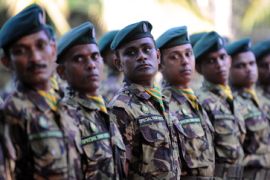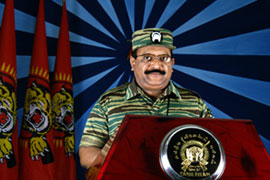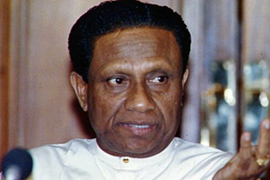Timeline: Sri Lankan conflict
South-Asian island has seen a 30-year separatist movement and 20 years of violence.

 |
| The Sri Lankan army has been intensifying its battle against the LTTE after a ceasefire between both sides officially broke down in 2008 [File: AFP] |
1949: Ceylon gains independence from British colonial rule. Divisiveness between the majority Sinhalese and minority Tamil ethnic groups begin to emerge on language, political, land and economic grounds.
1956: Sinhalese nationalist SWRD Bandaranaike wins elections. He declares Sinhalese to be the official national language. Tamil feelings of discrimination are heightened by agricultural programmes moving Sinhalese from the south to the east and newly irrigated land. The next two decades see sporadic communal violence and growing radicalisation of Tamil groups.
1972: Ceylon changes its name to Sri Lanka. Buddhism becomes the country’s main religion, increasing the feeling of ostracisation among the Tamils who are mostly Hindu.
Mid-1970s: Tamil politicians begin to call for a separate Tamil state – called Tamil Eelam – in traditional Tamil regions of northern and eastern Sri Lanka.
 |
| Velupillai Prabhakaran, the LTTE leader [File: AFP] |
1977: The Tamil United Liberation Front (TULF), employing a separatist ideology, wins every seat in Tamil regions in elections. Groups seeking to gain an independent state by force, such as the Liberation Tigers of Tamil Eelam (LTTE or Tamil Tigers), emerge.
1983: The LTTE kills 13 Sinhalese soldiers, instigating riots on a scale not seen before in the nation. Hundreds of Tamils are killed and 10,000 people displaced, with another 100,000 fleeing to south India. The riots mark the beginning of the dominance of ethnic conflict over Sri Lankan politics.
1987: The government launches a major offensive against Tamil control of the northern Jaffna Peninsula, which it had taken a year earlier, and regains most of the territory. The Indian air force intervenes, dropping aid packages to Tamils. A month later, the government signs a peace accord with India, providing for limited autonomy for Tamil regions, the disarming of separatist groups and an Indian peacekeeping force.
1990: Indian troops withdraw from the country, having lost about 1,200 soldiers as Tamil fighters resisted being disarmed. LTTE is in control of large areas of northern Sri Lanka.
1993: An LTTE suicide bomber kills Ranasinghe Premadasa, the president, and 23 other people at a May day rally.
1995: Chandrika Kumaratunga is elected president pledging to end the war and opens peace talks. A ceasefire is agreed, but the LTTE unilaterally resumes attacks three months later. The government decides upon a policy of military engagement with the separatists. By the end of the year, 500 troops and 2,000 Tamil Tigers have been killed.
1996: Up to 100 people are killed and 1,400 injured by a truck filled with explosives which is rammed into the central bank building in Colombo, the capital.
 |
| President Ranasinghe Premadasa was killed by a suicide bomber in 1996 [File: AP] |
2002: A ceasefire agreement is entered into leading towards talks to end the civil war sponsored by Norway. A government ban on Tamil Tigers is lifted and negotiations begin. Prisoners held by either side are exchanged for the first time and the demand for a separate state is dropped by the LTTE.
2003: The LTTE disengages from peace talks saying that it is not being given an equal voice. The ceasefire continues.
2004: Karuna, an eastern Tiger commander, splits from the LTTE and goes underground with his supporters. A suicide bombing occurs in Colombo, the first since 2001.
2005: Lakshman Kadirgamar, the foreign minister and an ethnic Tamil, is assassinated by the LTTE at his home in Colombo. The government establishes a state of emergency.
2006: The government and LTTE reassert their ceasefire agreement in Geneva in February, but bombings occur after April. Violence surges and hundreds of people are killed in attacks.
2007: The government takes increasing control of LTTE areas in the east. The LTTE carries out attacks in Colombo and on military installations.
2008: Government officially withdraws from the ceasefire and intensifies its crackdown on the LTTE. Fighting is concentrated on the border of the LTTE-held region in the north. Both sides accuse the other of bombings and assassinations in their opponent’s territories.